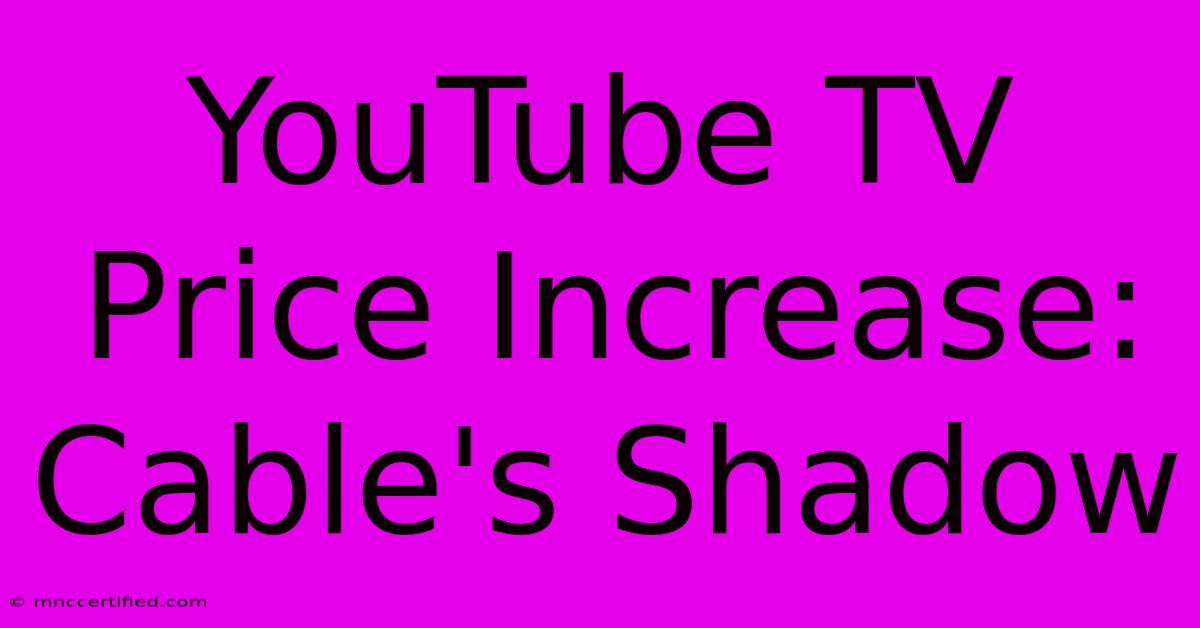YouTube TV Price Increase: Cable's Shadow

Table of Contents
YouTube TV Price Increase: Cable's Shadow
YouTube TV's recent price increase has sent ripples through the cord-cutting community. The move, while not unexpected in the ever-evolving streaming landscape, highlights a concerning trend: streaming services are increasingly mirroring the pricing strategies of traditional cable companies, casting a long shadow over the promise of affordable, à la carte television. This article delves into the reasons behind the hike, its implications for consumers, and what the future might hold for the streaming wars.
The Price Hike: A Deeper Dive
YouTube TV's base plan now costs $72.99 per month, a significant jump from its previous price point. While the company cites increased programming costs as the primary justification, many subscribers feel betrayed by the rising fees, especially given the ongoing inflation impacting household budgets. This price increase isn't an isolated incident; other streaming services have implemented similar increases, eroding the initial cost savings that drew many to cut the cord.
Why the Increase? Beyond Programming Costs
While rising licensing fees for channels are a major factor, YouTube TV’s price hike might also be a strategic move. The company may be aiming to:
- Increase Profitability: Higher subscription fees directly translate to increased revenue, allowing YouTube TV to invest further in content acquisition, technology, and service improvements.
- Compete with Established Players: To remain competitive with cable providers and other streaming platforms offering comparable channel lineups, YouTube TV needs to adjust its pricing.
- Manage Content Costs: Securing rights to popular channels and networks is expensive. The price hike could be a necessary measure to offset these expenses.
The Shadow of Cable: Are We Headed Back to the Old Ways?
The irony is palpable. Many consumers initially embraced YouTube TV and other streaming services as a more affordable alternative to traditional cable. However, the recent price surge is blurring the lines between the two models. This raises several key questions:
- Is the promise of affordable streaming dead? The rising costs suggest a potential return to the expensive bundled packages that characterized cable television.
- Will consumers return to traditional cable? The allure of predictable pricing (although arguably higher) might tempt some back to cable packages.
- What’s the future of cord-cutting? Will this trend push consumers towards more niche streaming services or towards piracy?
Navigating the Changing Landscape: What Can Consumers Do?
The rising costs of streaming services demand that consumers adopt a more discerning approach to their entertainment spending. Here are some strategies to help mitigate the impact of the price increase:
- Evaluate your viewing habits: Do you really need all the channels included in your subscription? Consider downsizing to a more affordable plan if possible.
- Explore alternative streaming options: Many cheaper alternatives exist, offering a smaller but still valuable selection of content.
- Embrace free streaming options: Free ad-supported services like Tubi, Pluto TV, and Crackle provide a cost-effective way to supplement your paid subscriptions.
- Bundle strategically: Explore bundles that combine streaming services with other services you use regularly, potentially offering discounted pricing.
The Future of Streaming: A Cloudy Outlook
The YouTube TV price increase serves as a stark reminder that the streaming landscape isn't as utopian as once believed. The industry is maturing, and the days of ultra-cheap, all-inclusive streaming packages may be numbered. The future will likely be characterized by a more fragmented ecosystem, with consumers carefully curating their subscriptions to balance cost and content. The battle for viewers is far from over, and the next chapter in the streaming wars promises to be a compelling one.
Keywords: YouTube TV, price increase, streaming services, cord-cutting, cable television, streaming wars, cost of streaming, affordable streaming, alternative streaming options, content costs, programming costs, consumer impact, future of streaming.

Thank you for visiting our website wich cover about YouTube TV Price Increase: Cable's Shadow. We hope the information provided has been useful to you. Feel free to contact us if you have any questions or need further assistance. See you next time and dont miss to bookmark.
Featured Posts
-
Le Bron James Out Vs Timberwolves
Dec 13, 2024
-
Nightreign Elden Rings New Co Op
Dec 13, 2024
-
82 99 You Tube Tvs New Price
Dec 13, 2024
-
Rams Vs 49ers Live Week 15 Watch Guide
Dec 13, 2024
-
Kari Lake Tapped For Voa Leadership
Dec 13, 2024